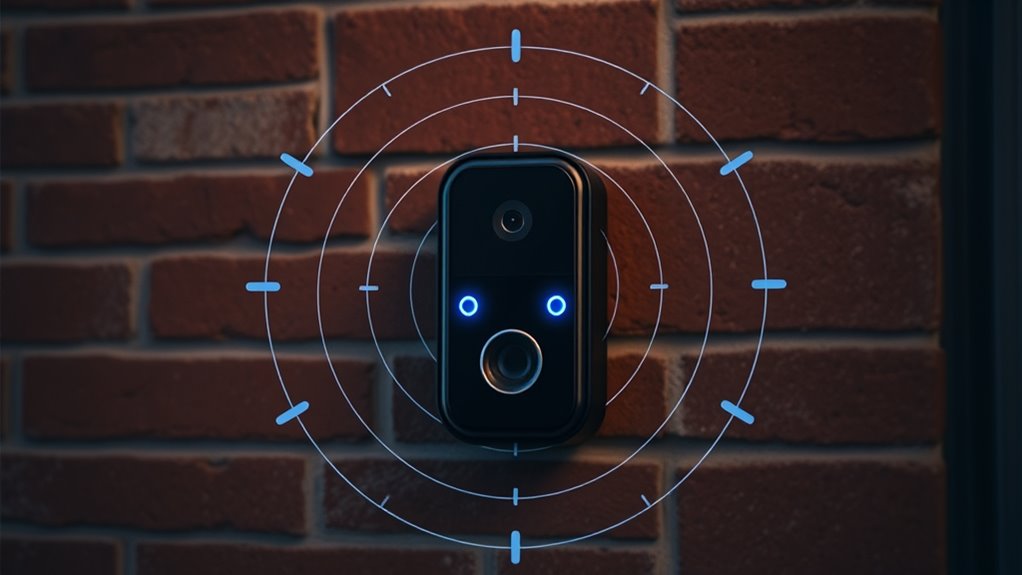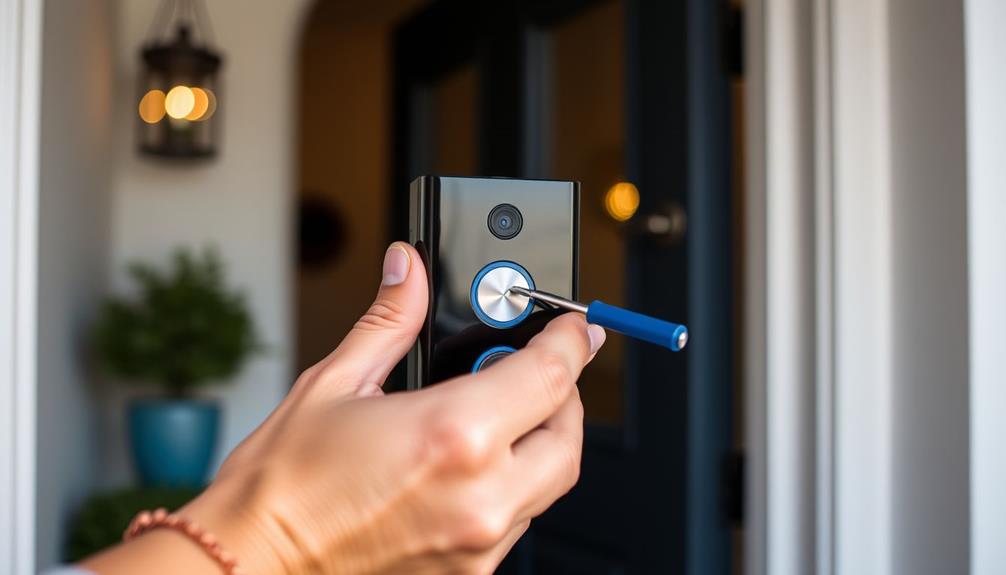Ring’s Radar Motion Detection works by emitting radio waves that bounce off objects and return to sensors, analyzing changes in the reflected signals to detect movement. It actively scans the environment, even through walls and obstacles, using advanced filtering and sensitivity adjustments to reduce false alarms. The system’s precise analysis helps distinguish genuine motion from environmental noise. If you’re curious about how this technology guarantees privacy and accuracy, keep exploring the details.
Key Takeaways
- Ring’s radar system emits radio waves that bounce off moving objects and return signals for detection.
- It analyzes changes in reflected signals, such as frequency shifts and timing, to identify motion accurately.
- Calibration and signal filtering reduce false alarms caused by environmental noise like foliage or passing vehicles.
- Radar detects movement regardless of lighting or weather conditions, providing reliable, continuous monitoring.
- All data processing occurs locally, ensuring user privacy by not sharing or storing detailed movement data externally.
Understanding Radar Technology in Security Devices

Radar technology in security devices works by emitting radio waves that bounce off objects and return to the sensor, allowing the device to detect motion even through obstacles like walls or foliage. This advanced detection method offers increased accuracy but also raises privacy concerns, as it can potentially monitor areas beyond your property. Additionally, installation challenges may arise because radar devices require precise positioning to avoid false alarms or blind spots. Proper placement is essential to maximize effectiveness and prevent privacy infringements. You need to contemplate how radar signals may penetrate neighboring properties or public spaces, which can lead to ethical dilemmas. Moreover, the range of detection of radar systems can vary significantly depending on the environment and device specifications, influencing how effectively they monitor your designated area. Overall, understanding these aspects helps you weigh the benefits of radar technology against potential privacy issues and installation complexities.
The Components of Ring’s Radar System
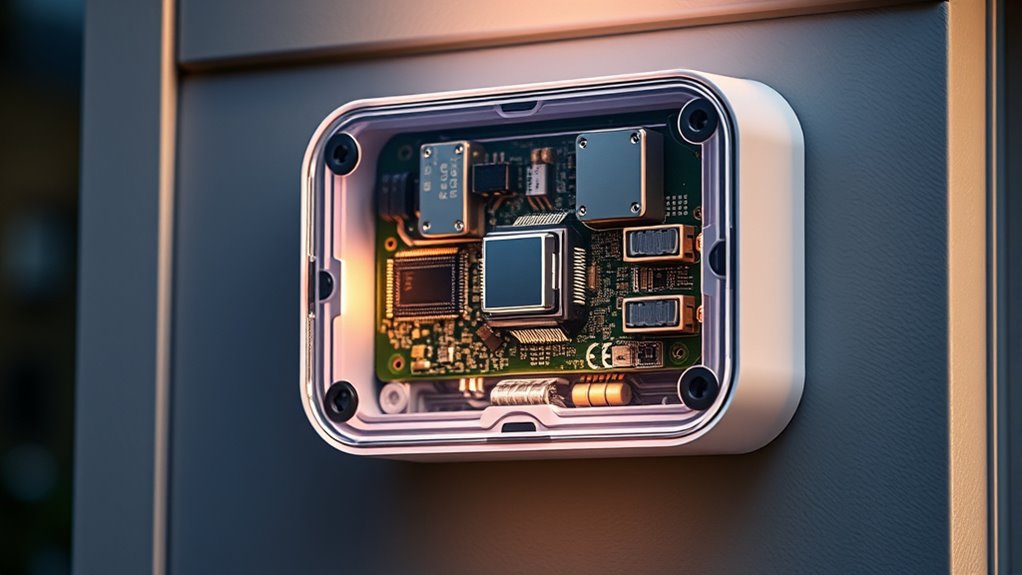
To understand how Ring’s radar system detects motion, it’s vital to familiarize yourself with its key components. The system relies on a radar sensor that emits radio waves and receives their reflections. Proper sensor calibration ensures accurate detection and minimizes false alarms, adjusting for environmental factors. Power management is essential, as the radar module needs to operate efficiently without draining your device’s battery. The system incorporates a processor that analyzes the radar signals, distinguishing between genuine movement and noise. Additionally, it includes circuitry that manages signal filtering and enhances sensitivity. Together, these components work seamlessly to detect motion reliably while conserving energy. Understanding these elements helps you appreciate the precision and efficiency of Ring’s radar-based detection, designed for effective security with optimized power use.
How Radio Waves Detect Movement
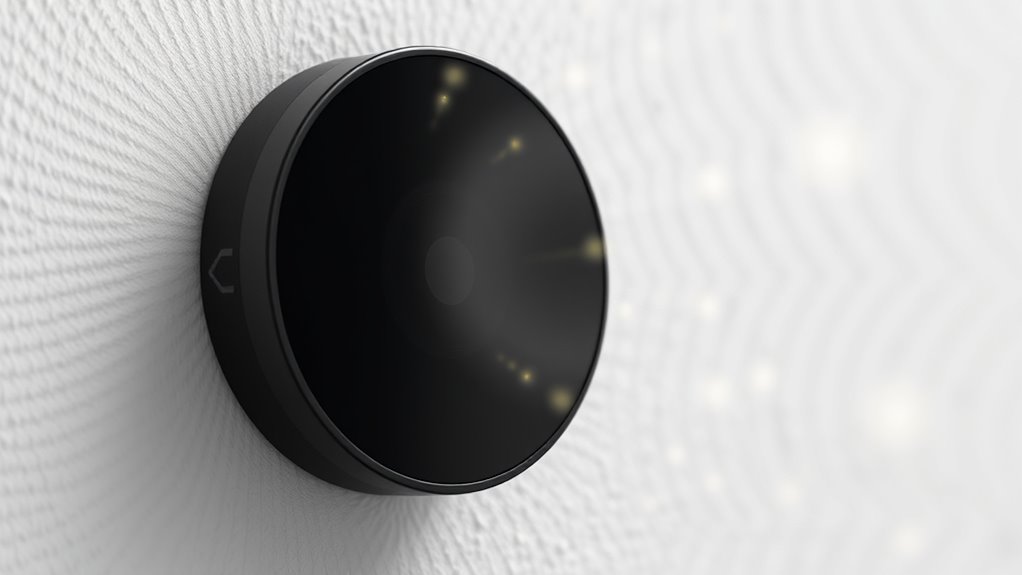
Radio waves detect movement by analyzing changes in the reflected signals they bounce back after hitting objects. When a person moves within the sensor’s range, their presence alters the reflected radio waves’ frequency and timing. These subtle variations are key to detection accuracy, allowing the system to distinguish between actual movement and false alarms. Proper sensor calibration ensures the device correctly interprets these signals, minimizing errors caused by environmental factors like clutter or interference. Calibration involves fine-tuning the radar’s settings to optimize sensitivity and filter out background noise. As a result, the system can reliably identify genuine movement, providing precise alerts. The contrast ratio of the projector image also influences how well details are rendered in dark scenes, which is crucial for an immersive viewing experience. This combination of radio wave analysis and calibration techniques helps maintain high detection accuracy, making your Ring device both dependable and efficient.
Differentiating Between Radar and Traditional Sensors
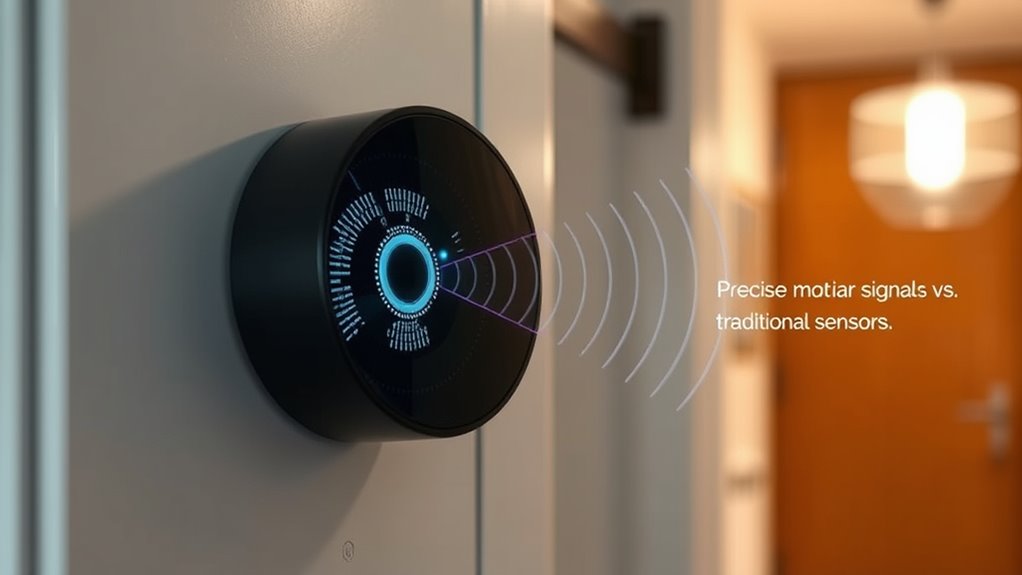
Understanding the differences between radar and traditional sensors helps you see how each detects motion. Radar uses radio waves to sense movement, while passive sensors rely on changes in temperature or light. Recognizing these distinctions in detection methods and signal processing makes it clear why radar offers unique advantages for security devices like Ring. Additionally, radar tuning involves adjusting the engine maps to optimize detection accuracy and minimize false alerts.
Radar vs. Passive Sensors
While traditional sensors like infrared or ultrasonic detectors rely on emitting signals and detecting their reflection, radar sensors actively emit radio waves that bounce off objects to determine motion and location. This active emission allows radar to work effectively in various lighting and weather conditions, unlike passive sensors that depend on detecting heat or sound. Radar systems often require precise sensor calibration to ensure accurate detection, especially since environmental factors can affect signal quality. Additionally, radar typically consumes more power than passive sensors because of the need to generate radio waves continuously. However, this increased power use pays off with better detection range and reliability. Sample-based techniques are sometimes used in radar signal processing to improve detection accuracy in complex environments. Passive sensors are more energy-efficient but may struggle with false alarms or limited detection capabilities in certain scenarios.
Detection Methodology Differences
Radar sensors detect motion by actively emitting radio waves and analyzing the reflected signals, whereas traditional sensors rely on passive detection methods like infrared or ultrasonic sensing. This active emission requires regular sensor calibration to guarantee accuracy, especially as environmental conditions change. Radar systems typically consume more power initially due to their continuous signal transmission, but their efficiency in detecting movement often balances out overall energy use. Traditional sensors usually have lower power consumption because they don’t emit signals constantly, but they can be less precise and more susceptible to environmental noise. The key difference lies in how each method interacts with its surroundings: radar’s active approach provides more reliable detection, while passive sensors focus on reducing power consumption at the expense of some sensitivity. Additionally, Preppy Dog Names are often chosen for their stylish appeal, which can also influence the personality traits attributed to certain detection systems.
Signal Processing Techniques
Radar sensors process signals by analyzing the reflected radio waves to detect movement, applying complex algorithms that filter out noise and distinguish between genuine motion and environmental interference. Signal processing techniques focus on signal enhancement to improve detection accuracy and noise reduction to minimize false alarms. These methods differentiate radar from traditional sensors by analyzing Doppler shifts and signal amplitude changes more precisely.
| Technique | Purpose |
|---|---|
| Adaptive Filtering | Reduce environmental noise |
| Doppler Processing | Detect moving objects precisely |
| Signal Averaging | Enhance signal clarity |
| Clutter Suppression | Minimize static interference |
The Process of Detecting and Analyzing Motion
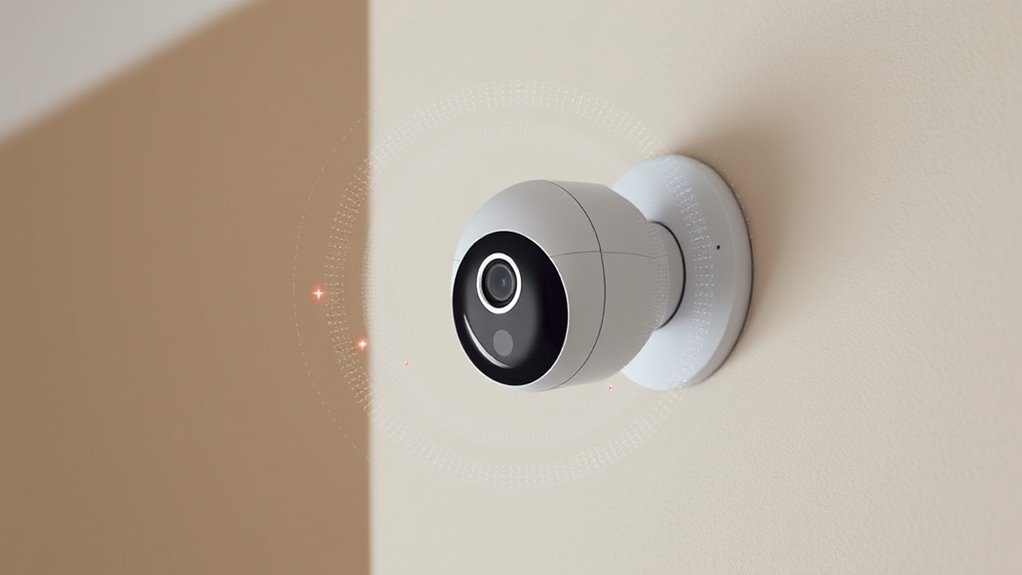
Detecting and analyzing motion involves the radar system emitting signals and interpreting the reflected echoes to identify movement. The system compares current signals with previous ones to detect changes, signaling movement in your environment. This process helps reduce false alarms and allows you to customize sensitivity settings, tailoring detection to your needs. Privacy concerns are addressed by ensuring data is processed locally and not stored or shared without your consent. User customization options enable you to adjust detection zones and sensitivity levels, giving you control over what triggers alerts. The system continuously refines its analysis to distinguish between genuine motion and environmental noise, enhancing accuracy. Additionally, incorporating principles from sensor technology improves the system’s ability to accurately detect subtle movements. Overall, this process combines precise signal interpretation with user preferences to deliver reliable, privacy-conscious motion detection.
Reducing False Alarms With Radar Precision

To minimize false alarms, your device uses advanced signal filtering to distinguish real motion from noise. Adaptive motion thresholds help it adjust sensitivity based on activity levels, while environmental interference mitigation reduces false triggers caused by external factors. These techniques work together to guarantee your Ring device alerts you only when it truly matters. Additionally, remote hackathons foster innovation and can offer new insights into improving detection technologies.
Advanced Signal Filtering
Advanced signal filtering plays a crucial role in minimizing false alarms by precisely distinguishing genuine motion from background noise. You rely on sophisticated filter algorithms to analyze radar signals and reduce interference caused by signal noise. These algorithms sift through the raw data, identifying patterns that indicate actual movement rather than random fluctuations or environmental factors. By filtering out extraneous signals, the system becomes more accurate and less prone to false triggers. This process ensures that your Ring device responds only to real motion, enhancing reliability. The combination of advanced filtering techniques and real-time analysis allows the radar sensor to maintain high sensitivity while avoiding unnecessary alerts. Ultimately, this refined filtering process keeps your home safer and your notifications more relevant. Additionally, ongoing algorithm improvements contribute to even greater accuracy and responsiveness in radar motion detection systems.
Adaptive Motion Thresholds
Building on sophisticated signal filtering, adaptive motion thresholds further refine the accuracy of your Ring device. These thresholds adjust dynamically based on motion calibration to distinguish real activity from false alarms. By fine-tuning sensitivity levels, your device reduces unnecessary alerts caused by minor movements or environmental noise. Adaptive thresholds analyze motion patterns over time, ensuring consistent performance even as conditions change. This process helps prevent false alarms while maintaining reliable detection. Additionally, understanding local laws can influence how you interpret and respond to detected motion events, further optimizing your device’s effectiveness.
Environmental Interference Mitigation
Have you ever wondered how your Ring device avoids false alarms caused by environmental factors? It uses advanced interference mitigation techniques to distinguish genuine motion from environmental sources like moving branches, passing cars, or shifting shadows. The radar sensors are designed to filter out these environmental factors by analyzing the consistency and pattern of detected signals. When interference sources generate sporadic or non-repetitive signals, the device recognizes them as false alarms and ignores them. Additionally, the system dynamically adjusts its sensitivity based on environmental conditions, reducing the chances of false triggers. This targeted approach ensures your device responds only to real motion, providing reliable alerts while minimizing disturbances caused by environmental factors.
Benefits of Radar-Based Motion Detection for Home Security
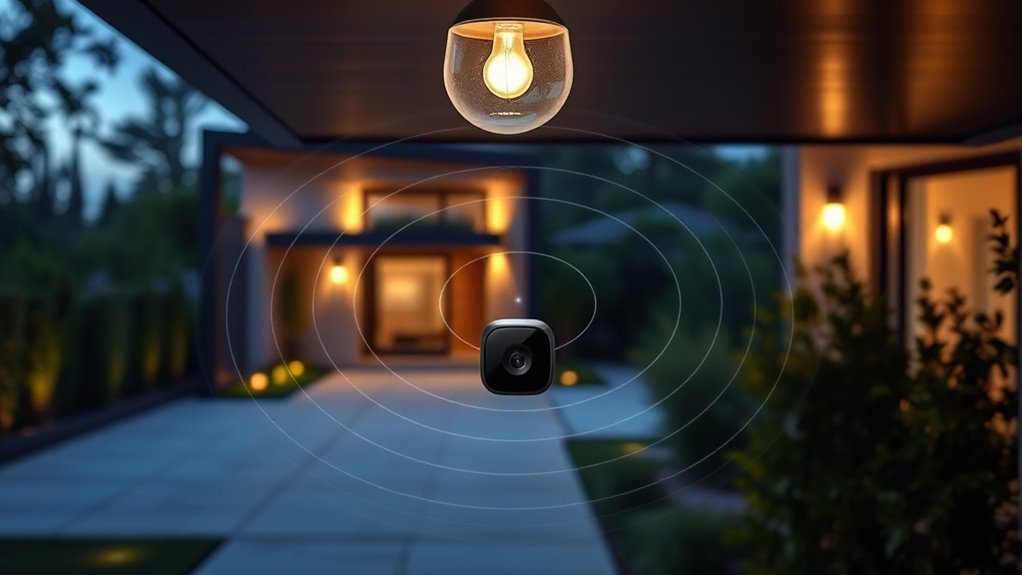
Radar-based motion detection offers several key advantages for home security, making it a reliable and efficient choice. It provides accurate detection even in challenging conditions like darkness, rain, or foliage, reducing false alarms. This technology also allows for quick, precise responses to movement, enhancing your safety. While some may worry about privacy concerns, radar systems are designed to detect motion without capturing detailed images, preserving your privacy. Additionally, radar’s long-term cost implications are favorable, as it typically requires less maintenance and fewer false alerts than traditional sensors. This efficiency means fewer unnecessary alerts and lower service costs. Overall, radar-based detection enhances security with its accuracy, privacy, and affordability, making it a smart investment for protecting your home.
Future Developments in Radar Motion Detection Systems

As technology advances, radar motion detection systems are poised to become even smarter and more integrated with smart home ecosystems. AI integration will enable these systems to analyze movement patterns more accurately, reducing false alarms and enhancing security. You’ll see smarter alerts tailored to your routines, making monitoring more efficient. Additionally, developers are focusing on energy efficiency, ensuring these systems consume less power while maintaining performance. This means your radar devices can operate longer without frequent recharging or battery replacements. Future innovations may also include adaptive sensitivity settings that automatically adjust based on time of day or activity levels. These improvements will make radar-based detection more reliable, seamless, and eco-friendly, giving you greater peace of mind while optimizing your home’s energy use. Incorporating antioxidants into these systems could further improve their resilience and longevity.
Frequently Asked Questions
How Does Ring’s Radar System Compare to Traditional Motion Sensors?
Compared to traditional motion sensors, Ring’s radar system offers more precise detection by actively scanning your surroundings. You’ll notice fewer false alarms because it uses advanced sensor calibration to distinguish between people and moving objects like trees or animals. This means your device reacts only to relevant motion, reducing unnecessary alerts. Overall, the radar system provides smarter, more reliable detection, making your home security more effective and less prone to false alarms.
Can Radar Detect Motion Through Walls or Other Barriers?
Imagine you’re curious if radar can see through walls. In reality, radar’s wall penetration depends on material; thick concrete blocks signal, while drywall allows some penetration. Signal interference from other devices can also affect detection. So, while radar can sometimes detect motion through thin barriers, it’s limited by wall type and interference, making it less reliable for through-wall detection in everyday settings.
What Privacy Measures Are in Place With Radar-Based Detection?
You might wonder about privacy concerns with radar-based detection. Ring addresses this by implementing strict data encryption, ensuring your footage and detection data stay protected. They also limit data sharing and provide clear privacy settings, giving you control over who accesses your information. Ring’s focus on privacy measures helps reassure you that your home security remains secure while using radar technology, balancing security needs with your privacy rights.
How Does Environmental Interference Affect Radar Accuracy?
Imagine radar like a delicate musical instrument; environmental noise and signal disruption can throw it off tune. These interferences cause inaccuracies, making it harder for your device to distinguish real movements from false alarms. Environmental interference from weather, objects, or other electronic signals can create static that muddles detection. To keep your system reliable, it’s essential to minimize these disruptions, ensuring your radar stays sharp and responsive.
Is Radar Motion Detection Effective in All Weather Conditions?
Radar motion detection is generally effective, but weather limitations can impact its performance. Heavy rain, snow, or fog may cause signal disruptions, reducing accuracy or triggering false alerts. While it works well in clear conditions, you should be aware that extreme weather can interfere with detection. To maintain security, consider supplementing radar with other sensors or cameras, especially during adverse weather, to guarantee consistent detection and minimize false alarms.
Conclusion
By understanding how Ring’s radar motion detection works, you can appreciate its advanced capabilities. Did you know radar sensors can detect movement up to 30% more accurately than traditional cameras? This means fewer false alarms and better security for your home. As technology evolves, expect even smarter, more reliable detection systems that keep you safer. Embracing radar-based security not only enhances protection but also gives you peace of mind knowing your home is monitored with precision.
